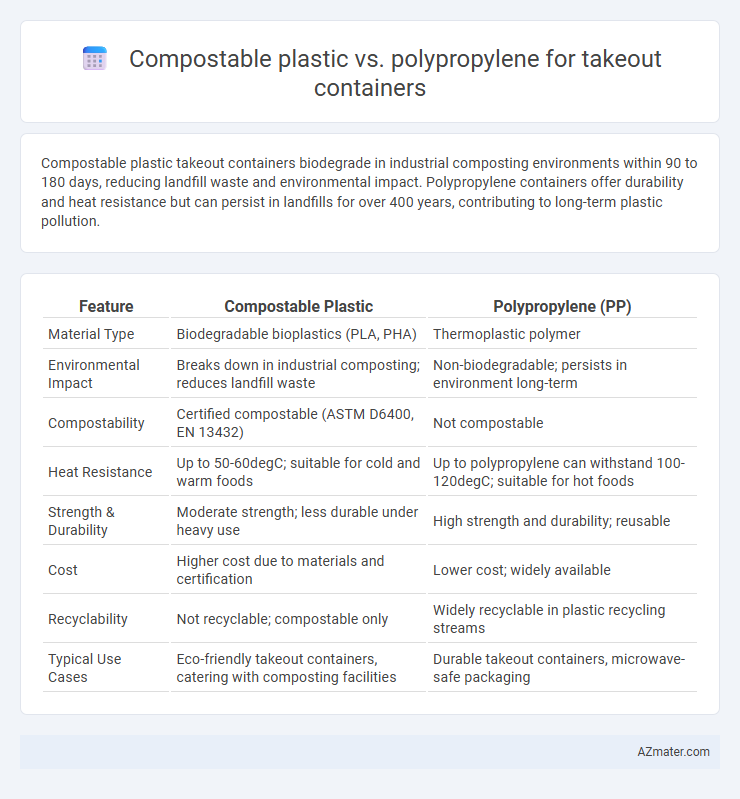Compostable plastic takeout containers biodegrade in industrial composting environments within 90 to 180 days, reducing landfill waste and environmental impact. Polypropylene containers offer durability and heat resistance but can persist in landfills for over 400 years, contributing to long-term plastic pollution.
Table of Comparison
| Feature | Compostable Plastic | Polypropylene (PP) |
|---|---|---|
| Material Type | Biodegradable bioplastics (PLA, PHA) | Thermoplastic polymer |
| Environmental Impact | Breaks down in industrial composting; reduces landfill waste | Non-biodegradable; persists in environment long-term |
| Compostability | Certified compostable (ASTM D6400, EN 13432) | Not compostable |
| Heat Resistance | Up to 50-60degC; suitable for cold and warm foods | Up to polypropylene can withstand 100-120degC; suitable for hot foods |
| Strength & Durability | Moderate strength; less durable under heavy use | High strength and durability; reusable |
| Cost | Higher cost due to materials and certification | Lower cost; widely available |
| Recyclability | Not recyclable; compostable only | Widely recyclable in plastic recycling streams |
| Typical Use Cases | Eco-friendly takeout containers, catering with composting facilities | Durable takeout containers, microwave-safe packaging |
Introduction to Takeout Container Materials
Takeout containers are commonly made from compostable plastics or polypropylene, each offering distinct environmental and functional benefits. Compostable plastics, derived from renewable resources like cornstarch, break down under industrial composting conditions, reducing landfill waste and promoting sustainability. Polypropylene, a widely used petroleum-based plastic, provides durability, heat resistance, and cost-effectiveness but poses challenges in biodegradability and recycling.
Overview of Compostable Plastic for Packaging
Compostable plastics for takeout containers are primarily made from renewable resources such as corn starch, PLA (polylactic acid), and cellulose, designed to break down in industrial composting facilities within 90 to 180 days. These materials minimize environmental impact by reducing long-term plastic pollution and supporting circular economy principles. Compared to polypropylene, compostable plastics offer enhanced sustainability but require proper waste management systems to ensure effective decomposition and prevent contamination in recycling streams.
What is Polypropylene and How is it Used?
Polypropylene is a thermoplastic polymer widely used in the packaging industry due to its durability, heat resistance, and versatility. In takeout containers, polypropylene is favored for its lightweight nature, ability to withstand high temperatures, and moisture barrier properties, ensuring food remains fresh during transport. This material's recyclability and low production cost also contribute to its extensive use in disposable food packaging applications.
Environmental Impact: Compostable Plastic vs Polypropylene
Compostable plastics significantly reduce landfill waste as they break down into non-toxic components within months under industrial composting conditions, unlike polypropylene which can persist for centuries. The production of compostable plastics often utilizes renewable resources and generates fewer greenhouse gas emissions compared to the fossil-fuel-based manufacturing process of polypropylene. However, improper disposal of compostable plastics in regular waste streams can negate environmental benefits, while polypropylene's recyclability remains limited by contamination and collection infrastructure challenges.
Degradability and End-of-Life Scenarios
Compostable plastic takeout containers break down within 90 to 180 days under industrial composting conditions, significantly reducing landfill waste and promoting nutrient recycling. Polypropylene containers, while durable and recyclable, can persist in landfills for hundreds of years if not properly processed, contributing to long-term environmental pollution. End-of-life scenarios for compostable plastics favor compost facilities, whereas polypropylene requires specialized recycling streams to avoid accumulation in waste systems.
Food Safety and Performance Comparison
Compostable plastics, often derived from plant-based materials like PLA (polylactic acid), provide excellent biodegradability but may have lower heat resistance and structural integrity compared to polypropylene (PP), which is known for its durability and high-temperature tolerance, making it safer for hot food storage. Food safety in compostable plastics can be compromised if not certified for food contact, whereas polypropylene is FDA-approved for direct food contact and resists chemical leaching. Performance-wise, polypropylene offers superior moisture resistance and mechanical strength, ensuring better protection during transport and storage of takeout meals.
Cost Analysis: Compostable Plastic vs Polypropylene
Compostable plastic takeout containers generally cost 15-30% more than polypropylene counterparts due to the higher price of plant-based raw materials and specialized manufacturing processes. Polypropylene containers benefit from economies of scale with fossil fuel-derived polymers, resulting in lower production expenses and retail prices. When factoring in waste disposal and environmental compliance costs, compostable plastics may offer long-term savings despite higher initial investments.
Consumer Perception and Market Trends
Consumer perception of compostable plastic takeout containers highlights environmental responsibility and biodegradability, driving demand in eco-conscious markets. Polypropylene containers remain favored for durability, cost-effectiveness, and recyclability but face scrutiny over plastic waste concerns. Market trends indicate a growing shift towards compostable alternatives, supported by regulatory pressures and increased consumer preference for sustainable packaging solutions in the food service industry.
Regulatory Compliance and Certifications
Compostable plastics for takeout containers often meet ASTM D6400 or EN 13432 certification standards, ensuring they biodegrade under industrial composting conditions, while polypropylene containers comply with FDA and EFSA regulations for food safety but lack biodegradability certifications. Regulatory compliance for compostable plastics emphasizes environmental impact and end-of-life disposal methods, promoting municipal composting acceptance. Polypropylene prioritizes durability and chemical resistance with established food contact approvals, making it a compliant choice for long-lasting, reusable containers.
Future Outlook for Sustainable Takeout Packaging
Compostable plastic offers a promising future for sustainable takeout packaging by breaking down into organic matter within industrial composting facilities, reducing landfill waste and environmental impact compared to traditional polypropylene containers. Polypropylene remains widely used due to its durability and cost-effectiveness, but ongoing advancements in biodegradable polymers and increased consumer demand for eco-friendly options are driving innovation toward compostable alternatives. The future outlook emphasizes integrating compostable materials with improved performance and scaling industrial composting infrastructure to meet the growing need for sustainable packaging solutions in the foodservice industry.

Infographic: Compostable plastic vs Polypropylene for Takeout container
 azmater.com
azmater.com